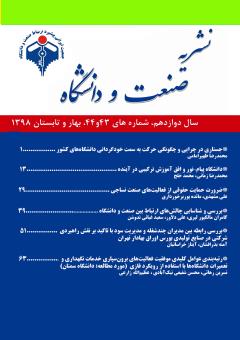دانشگاه پیام نور و افق آموزش ترکیبی در آینده
محورهای موضوعی :
1 - پژوهشگاه ملی مهندسی ژنتیک و زیست فناوری و رییس دانشگاه پیام نور
2 - عضو هیات علمی دانشگاه پیام نور
کلید واژه: آموزش باز, آموزش از راه دور, دانشگاه پیام¬نور, ساماندهی, آموزش ترکیبی, آموزش الکترونیکی.,
چکیده مقاله :
آموزش از راه دور، نظام آموزش نوینی برای سازمان دادن به فرآیند یادگیری – یادهی است، نظام آموزش باز به دليل ويژگيهاي ساختاري خود توان توسعه سريع كمي وكيفي را در زمانها و مكانهاي مختلف داراست. دانشگاه پیام نور به عنوان تنها دانشگاه دولتی، با نظام آموزش باز و شیوه آموزشی ترکیبی از مهرماه 1368 در 5 رشته تحصيلي و در 28 مركز، فعاليت آموزشي خود را آغاز كرد و تا ابتدای سال1390 دارای 512 مرکز و واحد بود. در سال 1396 به منظور اصلاح روشهای مدیریتی و چابکسازی تصدیگری و ایجاد تشکیلات و ساختار جدید به صورت منطقهای و در راستای تحقق بند یکم برنامه عملیاتی راهبرد یازدهم سند برنامه راهبردی دانشگاه پیام نور در افق 1419-1399 ساماندهی مراکز، واحدها و رشتههای تحصیلی دانشگاه در دستور کار قرار گرفت. در فاز اول طرح، 160 واحد از 490 واحد موجود در دانشگاه ساماندهی شده است و با تبدیل بخشهای علمی به دانشکدهها، رشتههای تحصیلی نیز ساماندهی شدهاند. طی سالهای 1396 تا 1399دانشگاه تلاش کرده که پژوهشها را به سمت کاربردی و کارآفرینی و خلاقیت سوق دهد. تأسیس چندین مرکز رشد، مرکز نوآوری و خلاقیت در استانهای مختلف نشان از جهتگیری دانشگاه به سمت دانشگاههای کارآفرین دارد. تقویت بستر الکترونی و استفاده بهینه از امکانات موجود برای بهبود فرایند تولید محتوا و نیز انجام آزمونهای الکترونی از جمله اولویتهای دانشگاه میباشد که در طول سه سال گذشته همواره مورد توجه بوده است. برنامه راهبردی دانشگاه پیامنور در توسعه آموزش الکترونیکی در سه حوزه فناوری، آموزش و سازمانی در حال انجام است. توسعه زیرساختهای مورد نیاز؛ توسعه ابزارهای آموزشی مدرن و مبتنی بر فناوریهای نوین؛ ایجاد ساختارهای سازمانی متناسب و نیروی انسانی آموزش دیده؛ تولید محتوای الکترونیک به روز، پویا و متناسب با نیاز؛ تامین منابع مالی و شخصیسازی آموزش بخشی از چشمانداز آموزش الکترونیکی دانشگاه پیام نور است.
Distance education is a new education system to organize the learning-memory process, the open education system due to its structural features has the ability to develop rapidly quantitatively and qualitatively at different times and places. Payame Noor University, as the only public university, with its open education system and a combined educational method, started its educational activities in 5 academic disciplines and 28 centers in October of year 1989, and had 512 centers and units until the beginning of 2011. In 2017 in order to reform the management methods and streamlining the enterprise and to create a new organization and structure in a regional manner and in line with the realization of the first paragraph of the 11th Strategic Action Plan of Payame Noor University, the organizing plan of the university centers, units and fields of study The agenda was put. In the first phase of the project, 160 units out of 490 units in the university have been organized, and by converting the scientific departments into colleges, the fields of study have also been organized. During the years 2019 to 2020, the university has tried to direct research towards application, entrepreneurship and creativity. The establishment of several growth centers, innovation and creativity centers in different provinces shows the orientation of the university towards entrepreneurial universities. Strengthening the electronic platform and the optimal use of existing facilities to improve the content production process as well as conducting electronic tests are among the priorities of the university that have always been considered during the last three years. Payam-e-Noor University's strategic plan for the development of e-learning in three areas: technology, education and organization is underway. Development of required infrastructure; Development of required infrastructure; Development of modern educational tools based on new technologies; Creating appropriate organizational structures and trained manpower; Production of up-to-date, dynamic and tailored electronic content; Funding and personalization of education is part of the vision of Payame Noor University e-learning.
1. فرج الهی، م؛ ده باشی شریف، ف، 1378، رشد آموزش از راه دور در ایران و جهان، دانشگاه پیام نور.
2. ظهور، ح، 1374، دانشگاه پيام نور در گذشته، حال و آينـده، مجموعـه مقـالات آمـوزش از راه دور، دانشگاه پيام نور، تهران.
3. Garrison, D. 1985, Three Generation of Technological Innovation in Distance Education; Distance education, 6,32,235-41.
4. Keegan, D. 2000, Distance Training Taking Stock at a Time of Change, Routledge, UK.
5. McIsaac, M.S. 2002, Editoriall, Past present and future of educational technology, Educational Media International 39 (2) 109-110.
6. prewitt,T. 1998, The development of distance learning delivery systems.higher education in Europe, XXIII,2,187-194.


